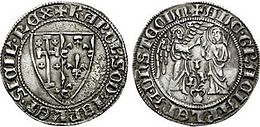Saluto (coin)


The Saluto or Carlino is a late medieval coin that has been minted since the reign of Charles I in the Kingdom of Sicily and Naples from 1278. As a gold coin it is called Saluto d´oro , as a silver coin it is called Saluto d´argento .
In a far-reaching coin reform, King Charles I introduced a silver coin based on the French model of Gros Tournoise in 1278 , which embodied the value of a penny several times in a single coin. This Saluto d'argento has a target weight of 3.39 grams and shows the proclamation scene from the Gospel of Luke in the New Testament : The angel Gabriel announces the birth of her son Jesus to Mary . At the same time, a gold coin with the same appearance was issued, which has a weight of 4.44 grams and a fineness of 950/1000.
The Saluto d´oro is one of the first late medieval gold coins in Italy, alongside the gold guilder from Florence (from 1252) and the ducat from Venice (from 1284). There is a smaller variant of both the silver coin and the gold coin, the ½ Saluto d´oro and ½ Saluto d´argento.
After the death of Charles I (1285), his successor, Charles II, continued minting the Saluto coins until his death in 1309. However, under this ruler there were no more ½ Saluti.
See also
literature
- René Frank : The Saluto d´oro - the almost forgotten gold coin of the late Middle Ages in: Trade journal Money Trend 2/2012
- Bernd Kluge : Numismatics of the Middle Ages . Volume 1: Handbook and Thesaurus Nummorum Medii Aevi , Vienna, Verlag der Österreichischen Akademie der Wissenschaften 2007. ISBN 978-3-88609-603-9